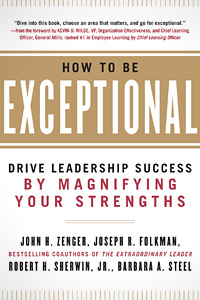The following are notes highlighted by Jim Clemmer from the book How to Be Exceptional, by John Zenger, Joseph Folkman, Jr., Robert H. Sherwin and Barbara Steel
 “In all our research to predict the satisfied, engaged, and committed employee versus the dissatisfied, disengaged, and uncommitted employee, one variable emerged as the best predictor of the differences. That one variable is, “Who is your immediate supervisor?”
“In all our research to predict the satisfied, engaged, and committed employee versus the dissatisfied, disengaged, and uncommitted employee, one variable emerged as the best predictor of the differences. That one variable is, “Who is your immediate supervisor?”
“… leadership strengths as those qualities that are highly valued in most cultures, that are valued in their own right, that can be developed through focused effort, that may be found in multiple leaders of an organization, and that have been shown to separate those perceived as the highest-performing leaders from those perceived as average or poor leaders.”
“… 72 percent of leaders should be focused on building their strengths. By not doing that, this large group is failing to benefit from the advantages of the building-on-strengths approach. Their leadership development efforts may still have an impact, but their effort will be sub optimized. So the biggest challenge in focusing on strengths … is our innate desire to fix our weaknesses.”
“… effective leaders are created through a mixture of “made and born” and that the weight of evidence is clearly on the side of leaders being made.”
“Those leaders who worked on strengths were more likely to:
- Create an excellent development plan
- Improve their overall leadership effectiveness
- Improve specific issues in their development plan
- Allocate appropriate time to development
- Put forth a concerted effort to work on their development plan”
“ … our research shows that self-perceptions tend to be only half as reliable as those from either peers or direct reports … we simply don’t know our strengths or weaknesses as well as we would like to think we do … the only way to get an accurate read of how you are doing as a leader is through the collective eyes of those you lead … bottom line, a leader’s ability to lead is highly determined by the reactions of others to that leader. Self-perceptions make little difference.”
“We have some new research that shows that there is an even better way to increase employee engagement. Surprisingly, the secret is for the manager to ask for feedback. The impact of asking for it is even more powerful than the impact of giving it. Here’s what happens to the percentile scores on employee engagement:
- 29th percentile — manager neither asks for, nor gives feedback
- 34th percentile — manager doesn’t ask, but gives feedback
- 48th percentile — manager asks to receive feedback, but doesn’t give feedback
- 74th percentile — manager both asks for and gives feedback”
For over 30 years, Jim Clemmer’s practical leadership approaches have been inspiring action and achieving results. He has delivered thousands of keynote presentations, workshops, and management team retreats to hundreds of organizations around the globe moving his audiences from inspiration to application. He’s listed in the World’s Top 30 Most Influential Leadership Gurus based on research with 22,000 global business people, consultants, academics and MBAs. His website is www.JimClemmer.com.

Be the first to comment on "How to be Exceptional"